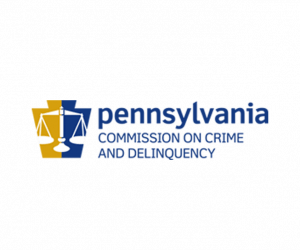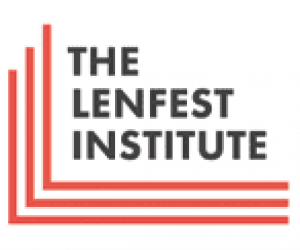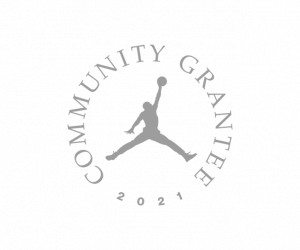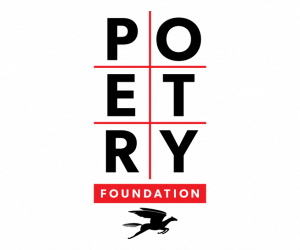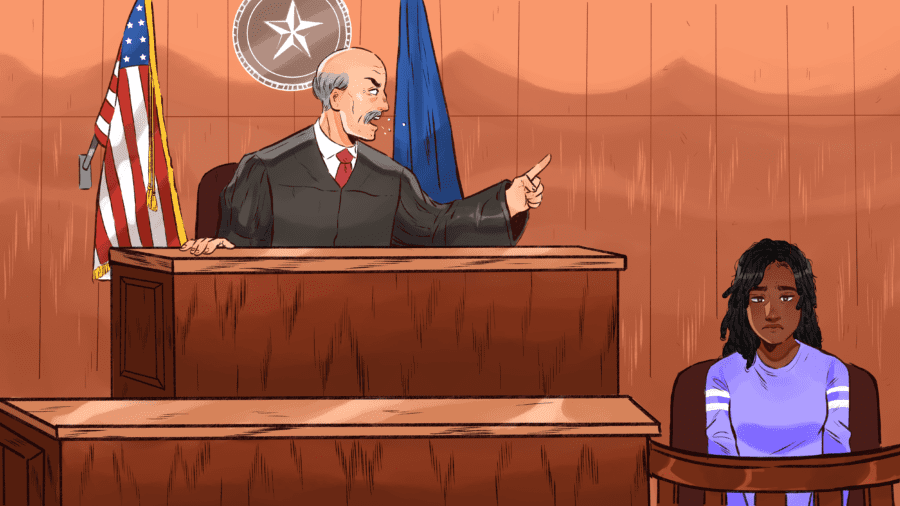
Former dependency court judge Lyris Younge was suspended earlier this year for mistreating parents and families, but court experts say disregard for case participants is not a “one judge problem.” Parents and families routinely get a very limited chance to speak.
Kids face less long-term trauma when they live with kin instead of foster families. Yet despite promising kinship placement models elsewhere and signs of improvement, Philadelphia’s child welfare system still appears biased against families.
By Steve Volk for Next City, Illustrations by Dylan B. Caleho
As Anita Buie frames it, the child welfare system was like a tidal wave that swept in and took her children, her voice cut off by the roaring water.
Buie had an open case with the Philadelphia Department of Human Services when, in November 2018, one of her kids suffered an accidental burn at his great-grandmother’s house. The incident led to the removal of three Buie children that had been living there in a multi-generational household.
Buie, since coming into DHS’s oversight, had been tasked by caseworkers to get help with parenting, her mental health and substance abuse. She reports that she had shuttled through treatment programs for some time, till she found one “that fit.”
The problem, however, is that parents and families in this situation face a ticking clock. The Adoption and Safe Families Act, passed during the Clinton administration, mandates a rush to “permanency,” presuming that children who cannot be reunified with their parents in a 15-month time frame should be moved toward adoption.
Buie, though, had maintained her hopes, collected letters of support from the counselors she had worked with, and looked toward her court date for validation. “Going to court was something I looked forward to, to make my case,” she says. “But every time I got in there, it was just like, no one was hearing me talk.”
During an October 2020 hearing, Judge Allan Tereshko cut Buie off repeatedly, then told her attorney, “You’re done. You had an appropriate amount of time” — before turning on Buie herself: “You’re asked a question and you give a 20-minute answer that’s got nothing to do with the question that was asked of you.”
What is striking, however, is that the transcript shows something else entirely. Across 12 pages of testimony, Buie tries repeatedly to answer the questions asked. Her average statement prior to finishing or being interrupted is 11.3 words. And her longest response is a cogent 87 words, which at an average speaking rate would take about 34 seconds to utter.
All told, Tereshko interrupts or speaks over Buie 22 times.
“It’s very common for parents to get a very limited chance to speak,” says Karissa Phelps, a former Stoneleigh fellow at Temple’s legal aid office, who recently finished a two-year project that examined kinship care and the dependency courts. “The courts are the forum where they’re supposed to be heard, but that often doesn’t happen.”
“This sort of thing happens every day,” says Kara Finck, a Penn Family Law professor. “Routinely, it’s the caseworkers who are afforded the greatest opportunity to talk.”
To correct this problem, advocates have offered up solutions, including a model to better-defend families (See Part One, “The Fight to Keep Families Together in Child Welfare.”) But some worry the bias against families is too deeply rooted to be rolled back by incremental reforms.
“I think these abuses against families, particularly families of color, are what the system was built on,” says Erin Miles Cloud, a former attorney in New York’s dependency courts and co-founder of the Movement for Family Power, which advocates for the abolition of the current child welfare system. “Which is why we believe, ultimately, we need to tear it down and do something new in its place.”
In the face of this, adopting new policies such as New York’s holistic defense model, or following good policies already on the books, says Miles Cloud, are “good intermediary steps.”
The real issue, though, runs deeper — into the hearts and minds of the people who operate the system as it stands.
DHS, DEFENDING A BROKEN SYSTEM
This April, a hearing took place on alleged abuses committed by dependency court judge Lyris Younge, who faced judicial discipline after it was revealed she verbally abused parents, prevented them from speaking and had parents arrested illegally, for contempt without cause.
Younge received a six-month suspension, a probationary period lasting till the end of her term in 2026, and will be barred from serving in Family Court, but the sanctions hearing that determined her fate revealed parents and families are still viewed as second-class citizens.
Repeatedly, as Younge’s victims recounted her abuses, the panel of judges on the Pennsylvania Court of Judicial Discipline allowed Younge’s attorneys to portray them as bad parents or bad people. “Didn’t your kids miss an average of 20 days of school,” Younge’s defense asked one parent about a case that revolved around truancy, as if excessive absenteeism should deprive a person of due process. In this, the hearing proved eerily reminiscent of sexual assault cases in which female victims are themselves put on trial.
Later, two DHS staffers even testified — not on behalf of the parent victims, but for the wayward judge, who they said they’d never witnessed behaving inappropriately.
Shirlana Dash told the panel she worked in dependency courtrooms, providing information on DHS policies and procedures, and described Younge as “respectful,” “compassionate,” “fair” and “stern if she needed to be.”
One of the judges on the panel then asked Dash to relate how other DHS employees had reacted to the case against Younge. Such a question was, in legal terms, a surprising solicitation of hearsay, allowing Dash to speak for an entire agency of people not on hand to verify her testimony. The answer, though, was telling.
“We thought it was strange,” said Dash. “We’ve never seen… any behaviors from Judge Younge that we’ve not seen from other judges on the bench.”
Dash clearly intended this observation as a defense of the judge, but her words inadvertently indicted the entire system and revealed some discomforting truths.
“Lyris Younge was the worst judge,” says one family lawyer, who wanted their name withheld to prevent retaliation in court. “But not, like, by a mile.”
Sarah Katz, who directs and teaches the Family Law Litigation Clinic, where her students serve clients in family law matters in Philadelphia courts, agrees: “This is not a one-judge problem. It’s a system-wide problem.”
The very idea that two DHS staffers had testified on behalf of a judge that a judicial discipline panel found guilty of “blatant,” “inexcusable” and “egregious” misconduct is itself a case in point.
Judges and caseworkers generally feel themselves to be on the same side, say family advocates, not just in the mission of “child welfare” — to protect children — but in very practical terms, to protect themselves.
Tragic child deaths spark massive scandals if that child victim was previously “system involved,” with either previous reports to DHS or an ongoing case. Media outlets that routinely spend little to no time covering the child welfare system suddenly provide daily coverage, poring over previous judicial decisions, hunting for people and institutions to blame. Case workers have even been charged with crimes, including four in Philadelphia indicted after the 2006 starvation death of Danieal Kelly, and four in Los Angeles after the 2013 beating death of Gabriel Fernandez.
This fear creates a troubling dynamic throughout the child welfare system: The majority of families coming through the courts don’t face any allegations of abuse in the first place, yet system professionals view each as a potential existential threat — not only to children but to their own professional reputations and careers.
That sense of threat, though, is usually one-dimensional: Workers fear a tragic incident in which a child is abused. But they don’t fear needlessly disrupting families, even though the damage of such an act can itself be tragic and life-long.
As an example, consider the recording that a mother not identified in this story played for me, of a phone call with high-level management at DHS. The call is long but in the most pivotal section a supervisor admits: We might have screwed up. Way back when this started, we should have put the child with family and we didn’t. But what can we do now? The child has been in a stable placement, and doing well where they are, for a long time.”
The admission was significant. In failing to place the child with family, the agency had torn a hole through that family that will never be healed. And given the data on how much better kids do when placed with kin, the child may actually suffer physically, mentally and emotionally from that wound for the rest of their life.
The consequence for DHS, though, is shattering: Nothing.
“There are lots of examples, right or wrong, of caseworkers being suspended or fired for failing to remove a child from a home where they were later abused,” says Richard Wexler, executive director of the National Coalition for Child Protection Reform. “But I’ve been researching this for more than 30 years, and I’ve never run across a worker who was disciplined for removing a child when it wasn’t necessary.”
The Younge case was unusual precisely because it did hold a member of the child welfare system to account for mistreating families. But it also didn’t spark the kind of pervasive coverage that a child death does, to question how the system functions as a whole. And so the public remains largely in the dark about a different kind of child abuse.
“The most coverage you see of the system,” says Finck, who helped found the pioneering family defense model that is working well in New York, “are these outlier cases, in which a child is tragically hurt or killed. Those cases should generate a lot of coverage, but what gets missed is that there are these daily tragedies occurring in court, every day, in which families and children also get hurt.”
PITTSBURGH’S KINSHIP LESSON FOR PHILADELPHIA
In February of this year, a city attorney admitted that the Buie children had to be moved out of their foster placement because of “inappropriate discipline and lack of supervision.”
In other words, the Buie kids appear to have been placed in a foster home in which they were abused — “inappropriate discipline” ringing as a possible face-saving euphemism for whatever occurred.
The new placement created an opening in which Buie’s attorney might have sought a placement with family instead. Her judge, though, Allan Tereshko, wouldn’t hear it: “The responsibility for placing the child in accordance with the law is on the Department of Human Services,” he said, “and they must do family finding and comply with other requirements under the law. The mother may offer suggestions to the Department, but… I’m not going to enter into the fray. The Department has the burden. The Department has the responsibility.”
Reviewing this same section with several different family law attorneys, including Finck and Katz, the reaction was the same: Tereshko had indicated that he would simply trust DHS, refusing to act as a check and balance on a government institution with incredible power.
Miles Cloud, of the Movement for Family Power, notes Tereshko’s admission of partiality, is something she also heard over the years in New York. “Multiple judges had said basically the same thing to me, behind closed doors,” she says. “They said, ‘I trust the caseworkers.’”
The entire series of events breaks great-grandmother Elizabeth Buie’s heart.
Elizabeth Buie had been the daily caregiver to the children when one of them received an accidental burn in her home. She treated it herself, with her past experience as a nurse to guide her.
“Those children never went hungry,” she says of the daily care she provided, citing the bacon, eggs and waffles she cooked, “and they knew they were loved.”
Even now, their great-uncle, 55-year old Bert Buie, waits to take them in: “We tried to express to the agency that it doesn’t have to be this way,” says Bert Buie. “We’re a family, and we can take care of our own.”
The children’s mother, Anita Buie, does appear to face a host of challenges. What she has of her case file, which she shared for this story, is thick, documenting episodes in which she denied needing services and was verbally hostile to caseworkers. She was required to take anger management courses, and faced a pair of 2020 arrests, for burglary in one case that was withdrawn and terroristic threats in another that remains open. The questions, for an overburdened child welfare system, are enormous: At what point is it appropriate to give up on a mom?
But these existential questions apply to a child’s extended family as well. In so many of these cases, family can provide support so that a child is still there with the people who have loved them longest and most; and so that any mom or dad, going through a tunnel of hard times, has an opportunity to emerge on the other side and step back into the lives of their kids.
Philadelphia has made big strides in placing kids with kin, an option that results in far better long-term outcomes for youth. Kinship placement rates are now topping 50%. But there are places doing better, including Allegheny County, which is pushing up near 70% for the Pittsburgh area.
The key, says child welfare expert Sharon McDaniel, is intentionality. “This is an agency issue,” she says. “It’s on the agency to… find and work with families.”
These words, coming from McDaniel, should resound at great volume. As president and CEO of A Second Chance, McDaniel has been providing kinship services in Allegheny County for more than 25 years, and for roughly 18 years in Philadelphia. In Allegheny County, A Second Chance’s staff, actually housed in the same office and supporting the same team that ultimately chooses where a child should be placed, finds and vets prospective kinship candidates. In Philly, that vetting is done either by DHS or the city’s Community Umbrella Agencies, a series of regionally placed offices that critics say suffer from high staff turnover and general inexperience.
From a caseworker perspective, placing kids with kin is harder than putting them with a stranger. “The foster parent has already gone through the licensing process,” says McDaniel, the house and parent both already vetted and determined to meet every requirement. “The kinship parent has not done any of that, and there might be things they need to do.”
Maybe grandma doesn’t have a working smoke detector on the first floor, or they need to get an additional bed. “A caseworker might see that and just check the box, ‘not qualified,’” says McDaniel, but kids can be placed for up to 60 days in a kinship home that has yet to meet all the necessary licensing requirements.
“We walk the family through it,” says McDaniel, saying they have a culture at A Second Chance of “licensing kin in, rather than licensing them out,” helping them in that 60-day period, if need be, to come into compliance. The extra effort involved either requires workers with an internal sense of want to, in order to do it, or “leadership” that demands it.
In this sense, the stage at which A Second Chance’s services occur in the system — pre-placement in Allegheny County, post-placement in Philadelphia — looms large.
“Placing kids with family is a commitment,” says William Browning, executive director of the Lackawanna County Department of Human Services, which has also made strides in recent years. “And it starts with supervisors and the tone they set.”
When a removal occurs, the supervisor should ask: Why isn’t this child still in their original home? And if the child did have to be removed, why isn’t this child with kin?

McDaniel offers Philadelphia some significant praise, noting that when she first started providing services here, almost two decades ago, the city’s kinship placement rates were below 20%. But she also sees room for improvement, and points toward not just the outward actions and policies of the child welfare system, but the core beliefs of the people running it.
“There is an ‘apple doesn’t fall from the tree’ mentality that persists in this field,” says McDaniel. “And we really need to dismantle that ideology, which is steeped in pathologizing groups of people…particularly Black and Brown families.”
She notes that Allegheny County had set 70% as a goal for kinship placements, but now seeks to push higher, “as high as we can get,” because “we know from data that kids do better with their families.”
Allegheny County also enjoyed highly stable leadership for a long time, with recently retired DHS director Marc Cherna emphasizing kinship placements as an agency value for around 25 years. For Philadelphia to draw even, says McDaniel, “it really has to be that you set an infrastructure that values family. And so I would look at who is in the decision-making roles, your designs, your systems, your structures. Does it support this notion that families should be first?”
The words McDaniel and Browning use, such as “intentions,” “commitment” and “values”, are perhaps even more illuminating because they speak not just to policies but to internal, even emotional states. In this sense, Philly’s lower numbers suggest this city still has room to grow not just its kinship rates but the culture and values that underlie them. And the extended Buie family, ready to step in for mom Anita Buie and provide for their own, are among those who might be paying the price.
“There was an accident,” says Bert Buie. “That’s what it was. … But it feels like they just treat everything the same way, and do not really look at the individual situation.”
A SYSTEM WITHOUT FAIRNESS OR COMPASSION GRINDS ON
In June, the Buie case reached a possible end point, a hearing in which Anita Buie faced the termination of her parental rights—known colloquially as a “TPR.”
The hearing, coming out of the pandemic, included electronic communications as well as in-person testimony. By law, TPR hearings are supposed to give parents an opportunity to speak. However, in this case, when the father’s cell phone connection yielded repeated dropouts, Tereshko cut him off.
“[He] has waived his right to present evidence,” Tereshko stated, though the court stenographer’s notes capture the man still trying to be heard.
“Hello?” he said.
“Because of his failure,” the Judge continued, “he and his attorney’s failure to secure a good line of communication and be in a position to present testimony to the Court just like everyone else on this call.”
TPRs are the equivalent of capital punishment for parents — ending any legal rights they have to their child, as well as visitation rights. Cutting a parent off from speaking at a TPR should be recognized as an extreme step, like denying a defendant a right to testify in his own defense. But beyond the potential legal concerns, there is a human element to the incident, too — the judge denying a father his last opportunity to speak for his child over a technical snafu.
“The family regulation system routinely denies the humanity of parents and families,” says Miles Cloud. “It doesn’t look at the relationships, the caring, and love.”
Mother Talea Griggs, from Part One of this story, says a caseworker actually taunted her at an October hearing. “She walked over to me during a recess and laughed in my face,” says Griggs. “I was like, ‘How can you look at any of this as funny?’”
In another example, this one involving a judge, West Philly resident Bridget Powell can present five long years of text, email and court records, showing her family’s efforts to get a niece in DHS custody placed with family, including her own siblings. Powell herself is certified as a kinship parent, so the system’s failure to place blood with blood here appears inexplicable. Yet one judge who oversaw the case took a hard line, saying: “…this family is a nuisance” in open court.
“I’m so sick of these people,” said Judge Vincent Furlong. “They’re throwing motions to intervene for three years now. The child had — this child has never been in their care.”
The child had never been in the family’s care only because DHS had refused their pleas. And they were fighting over existential concerns — to keep blood with blood, to raise a niece who would grow up to understand that she originates from a family with love in their hearts and strength enough to raise her. Furlong, by contrast, was just lamenting his packed schedule.
Such episodes suggest a deficit of empathy among some child welfare professionals, which could itself be attributed to a mental health condition. According to the Children’s Bureau of the U.S. Department of Health and Human Services, “child welfare professionals are subject to burnout, compassion fatigue and secondary traumatic stress.”
“Employee wellbeing is a priority,” says a DHS spokesperson, in detailing several internal and external programs offered to front-line staff. “We find ways to help staff get the help they need to address the impact of trauma on their own lives, and to look systemically at how we can mitigate secondary stress for child welfare workers.”
From the perspective of children and families, compassion fatigue might be the worst problem — the child welfare worker protecting themselves by becoming numb to the suffering of others.
Buie, certainly, felt and experienced as much.
The attorney for her TPR hearing tried to present evidence showing she’d attended to the core issues child welfare workers had asked her to address. He tried to introduce documents from relevant agencies, listing the classes she’d attended and the treatment she received, along with letters of support from counselors. The city attorney, however, objected, saying Buie’s attorney needed to call witnesses to testify to the veracity of each document.
Judge Allan Tereshko tried to walk Buie’s attorney through the proper way to introduce evidence. Shortly afterward, however, the attorney failed again, raising questions of whether Buie simply had ineffective counsel. And the city bore down on her, hard.
“Your grandmother that you’re residing with, isn’t it true that she was also involved in one of the incidents with the burn of your child?” asked the city solicitor.
“Yes, it was an accident,” replied Buie.
“Right,” the attorney responded. “So it obviously — your current housing would not be appropriate given that this individual currently resides in that home, correct?”
Buie had a good case to make for her family: Her grandmother, who used to work as a nurse, provided treatment to the child. But the attorney pressed on — criticizing Buie for failing to maintain an orderly schedule of doctor’s visits. The tragic irony is that many families would consider treating a child’s burn with ice, Neosporin and a bandage proper parenting. But in this case, it was used as evidence toward splitting up a family.
Tereshko, at the hearing’s conclusion, terminated Buie’s rights and declared that she lives “in a fantasy world…. The very fact that she wants to live in a home with a grandparent who was involved and responsible for the original injuries that brought this child into care suggests that she has no concept of reality.”
Just who has fallen out of touch with reality, however, remains an open question: Is it the judge, protecting kids from an old woman who wants to cook them waffles? Or the mom, who wants to return her children to that same home?
Buie, for her part, now feels the entire system was just “playing games” with her from the start. And Elizabeth Buie, still prohibited from interacting with her great-grandchildren, starts to cry as she recalls one fairly recent phone call she managed with one of the boys. “He said ‘nonny, do you know what I miss the most? I miss your waffles and hash browns.’”
Like any loving grandma, Buie focuses in, tight, on food. “That boy, missing my cooking, tells me they ain’t cooking for him the same way,” she says. “Why? Because they do not love them the way we do. We love those kids. So you tell me? How are those children better off?”
Cynthia Mitchell, the grandmother eliminated from her grandchildren’s lives by an old criminal record (See Part One), frames the whole experience as changing her in ways she never imagined. “I was a happy person, always up,” she says, “and I felt good about myself. Now I am miserable all the time, and ugly.”
She bursts into tears, barely getting the words out. “I used to think having one of my children die would be the worst thing I could face,” she says. “Now I know different. Because there is nothing worse than losing a child who is still alive.”
EDITOR’S NOTE: This is the second of a two-part series that highlights the uphill battle many families face in navigating the Philadelphia child welfare system. These articles are part of “Our Kids,” a project of Resolve Philly reporting collaborative that examines the challenges and opportunities facing Philadelphia’s foster care system. Read the first story in this series, “The Fight to Keep Families Together in Child Welfare.”


